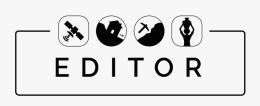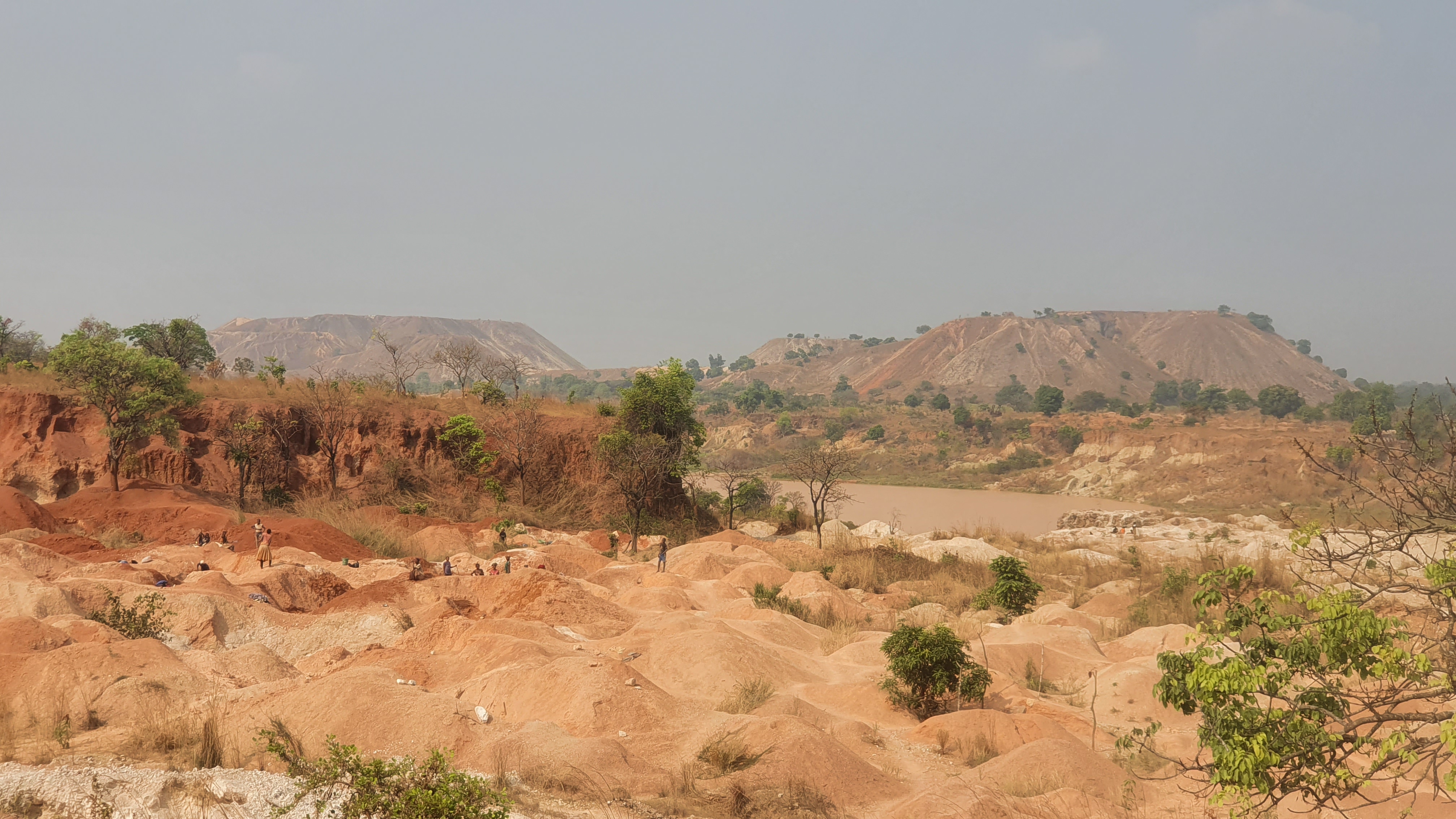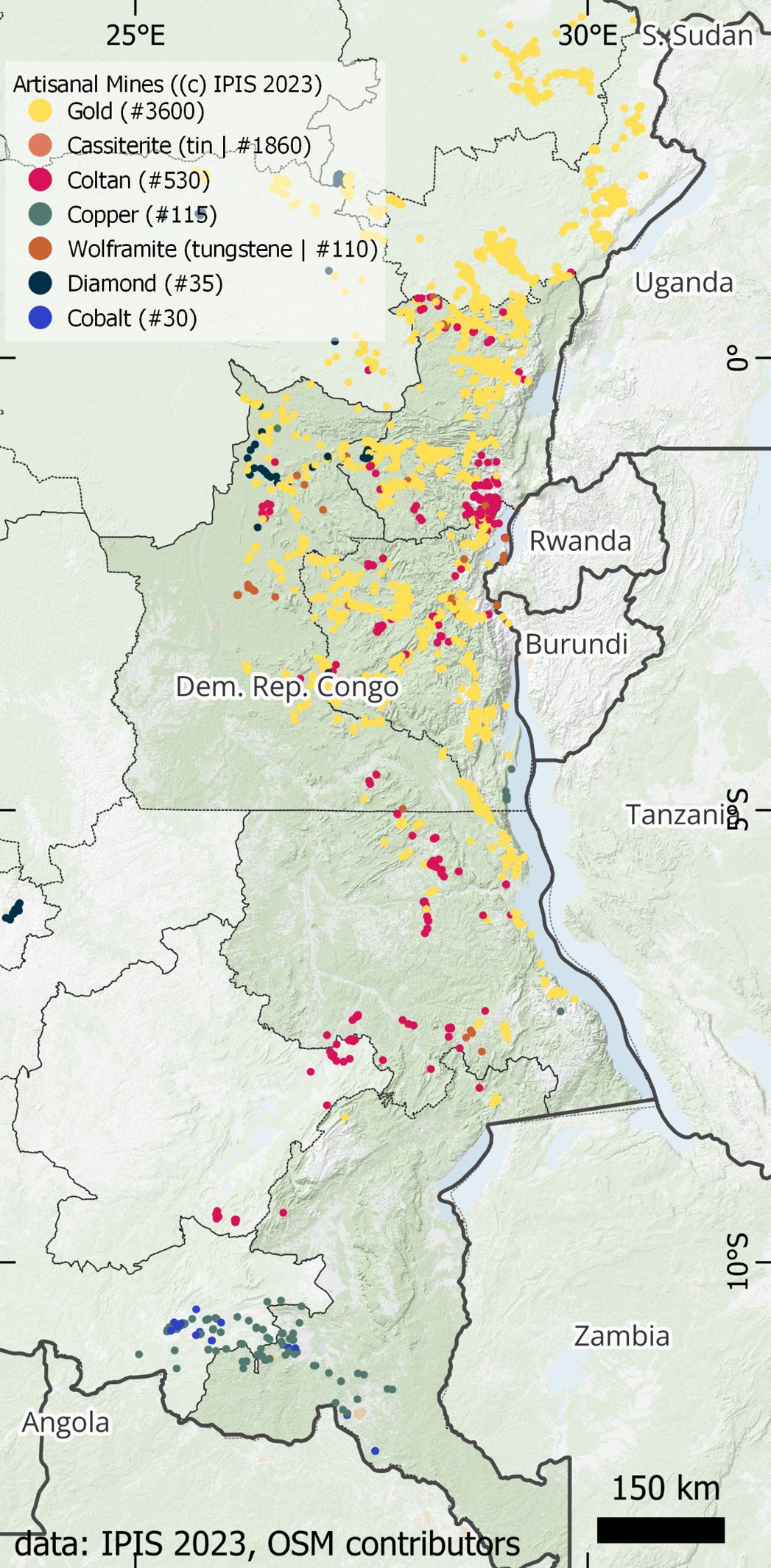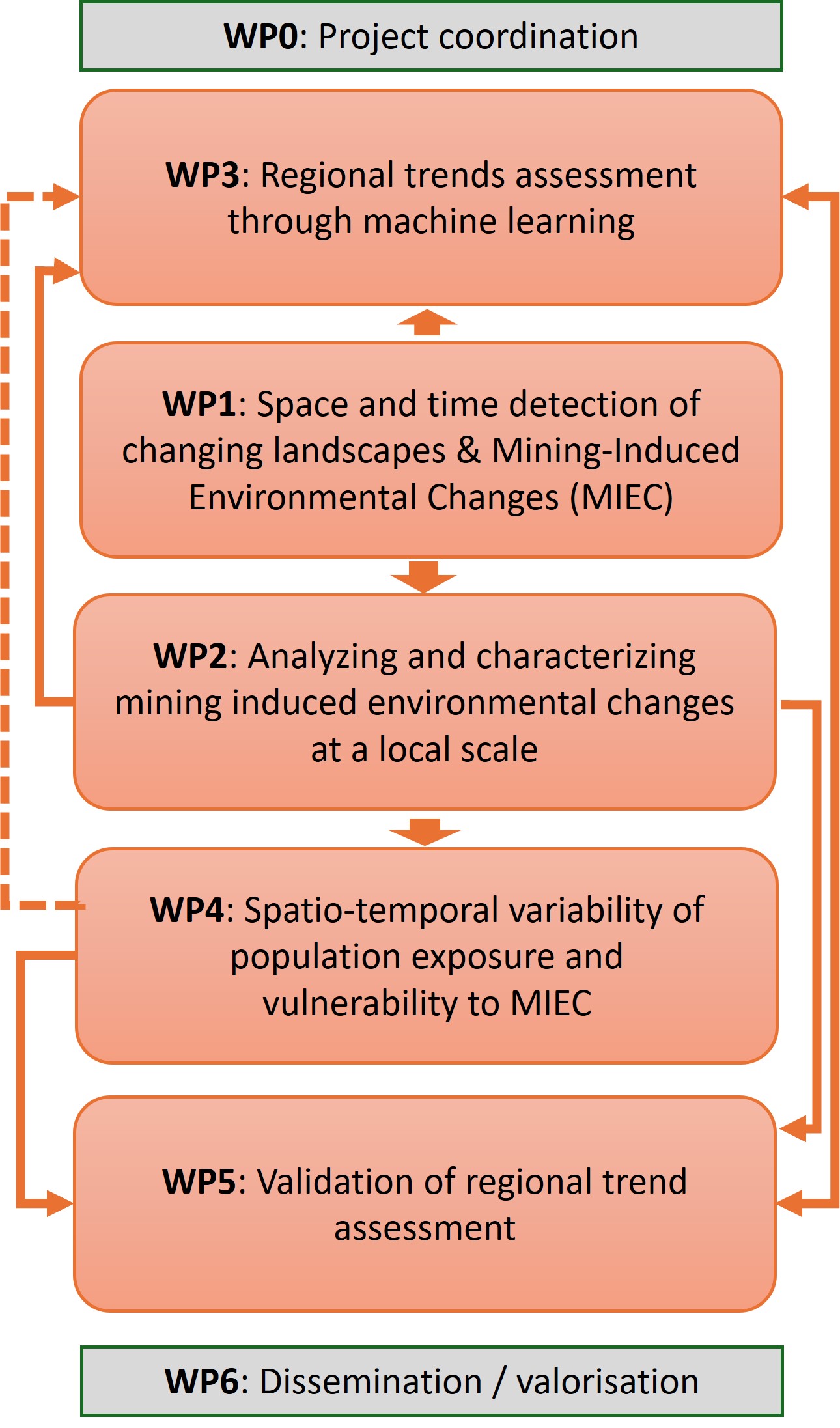EDITOR
Risques environnementaux associés aux activités minières sous les tropiques : une approche holistique des risques dans l'est de la République démocratique du Congo

En utilisant des techniques avancées d'observation de la Terre, le projet EDITOR (2024-2029 ; STEREO IV) cherche à évaluer dans quelle mesure l'activité minière et les perturbations du paysage qui en découlent, y compris l'installation et la croissance des villages à proximité (zone d'influence de la mine), provoquent ou amplifient la prévalence des aléas géo-hydrologiques qui affectent l'environnement. Le projet se concentre sur l'exploitation minière artisanale (ASM) et industrielle (LSM), et évalue les impacts de la mobilisation du sol et de la roche, de la création de conditions de pente instables, de la sédimentation en aval, ou de l'apport ou de la concentration de substances toxiques utilisées dans le traitement des minerais, le tout dans des zones densément peuplées.
EDITOR s'appuie sur le large éventail d'expertise au sein du consortium dans l'utilisation de l'imagerie satellitaire multi- et hyperspectrale, de l'imagerie radar et de ses dérivés, ainsi que des images optiques à haute résolution. Il s'appuie également sur une connaissance avérée des mécanismes à l'origine des aléas géo-hydrologiques dans les environnements tropicaux, ainsi que sur une expertise au sol et en laboratoire des contextes géologiques, minéralogiques et sociétaux spécifiques. En effet, le projet bénéficie de l'expertise et des méthodes en sciences sociales nécessaires pour évaluer la vulnérabilité des populations exposées aux changements environnementaux induits par l'exploitation minière. EDITOR s'appuie sur des activités scientifiques existantes et rassemble un réseau de chercheurs et de partenaires experts de terrain ancrés dans les institutions scientifiques congolaises pertinentes dans la région étudiée. Le traitement de ce volume considérable de données nécessite des capacités accrues en matière de techniques d'apprentissage automatique (Machine Learning), permettant la construction d'un outil automatique de détection et de suivi des changements environnementaux, qu'ils soient ou non induits par l'activité humaine.
Ce projet de 5 ans est financé par la Politique Scientifique belge (BELSPO) dans le cadre du programme STEREO IV et est coordonné par le Musée royal de l'Afrique centrale, en collaboration avec le Centre spatial de Liège (CSL), la Faculté des sciences de l'information géographique et de l'observation de la Terre (ITC) de l'Université de Twente et l'Institut de la politique de développement de l'Université d'Anvers (UAntwerp).
La réunion de lancement d'EDITOR a été organisée le 6 juin 2024 à Bukavu (RD Congo), en présence des institutions partenaires (CEGEMI, CIRRINA et SGN) et des parties prenantes impliquées dans l'étude des changements environnementaux en général, et dans les environnements miniers en particulier. Regardez la vidéo ci-dessous (merci Sara)!
Contexte & Objectifs
Les engagements mondiaux en matière de changement climatique et la mise en œuvre rapide de la transition vers des technologies « vertes » ont entraîné une forte augmentation de la demande de matières premières et, par conséquent, une hausse des prix des produits de base. Cette ruée sur les ressources naturelles a entraîné une intensification des activités minières (souvent non réglementées), tant industrielles qu'artisanales. Les activités minières perturbent le paysage directement sur les sites d'exploitation : puits à ciel ouvert et terres excavées, tas de déchets, coupes de pentes et usines de traitement. Elles entraînent également des changements à l'extérieur des sites, parfois à des kilomètres de distance, tels que la construction de routes, le développement de nouvelles zones d'habitation, la déforestation et la réorientation de l'agriculture. Les activités minières sont également associées à des problèmes de santé (pollution des sédiments et des rivières, contamination des sols et des cultures vivrières, pollution par les poussières). Dans l'ensemble, les activités minières entraînent des changements sociétaux et démographiques qui influencent la vulnérabilité de la population exposée aux aléas géo-hydrologiques.
EDITOR vise à aborder la question des changements environnementaux liés à l'augmentation des activités minières induites par la demande mondiale de métaux, notamment dans le contexte des engagements mondiaux en matière de changement climatique et de la mise en œuvre de technologies « vertes », et des impacts sociaux liés à l'exploitation minière, tels que l'augmentation rapide de la population et les changements d'utilisation des terres, qui restent jusqu'à présent soit sous-étudiés, soit peut-être sous-estimés dans la région ciblée (est de la République démocratique du Congo). Dans la perspective d'une exploitation durable des métaux critiques pour faire face à leur utilisation exponentielle, cette approche est fondamentale pour prendre en compte les intérêts et les priorités des populations et des pays concernés.
Les objectifs spécifiques du projet sont les suivants:
- SO-1: Détecter, dans l'espace et dans le temps, les changements environnementaux induits par l'exploitation minière (MIEC)
- SO-2: Analyser et caractériser les MIEC détectés à l'échelle locale
- SO-3: Évaluer la tendance régionale des MIEC à l'aide d'une approche d'apprentissage automatique
- SO-4: Caractériser la variabilité spatio-temporelle de l'exposition et de la vulnérabilité de la population aux MIEC.

Région d'étude

La zone ciblée est la partie orientale de la RDC, connue pour sa concentration de ressources géologiques, en particulier de minéraux essentiels tels que le cobalt, le cuivre, l'étain, le coltan et l'or. Cette région se caractérise par une forte densité de différents types de sites miniers, impliquant une large population qui dépend directement ou indirectement de l'exploitation minière pour ses revenus, et qui est directement ou indirectement affectée par ses conséquences environnementales et sociales.
L'extraction artisanale et semi-industrielle du coltan, de l'or et de l'étain est généralement réalisée à partir de gisements de surface tendres et peu profonds, par le biais d'excavations à ciel ouvert et de trous creusés à la main dans la couverture sédimentaire tendre, sans l'utilisation de machines modernes. La récupération des minéraux ne nécessite généralement que l'utilisation d'eau pour séparer les minéraux denses du minerai des déchets plus légers, ce qui augmente la charge sédimentaire des rivières et risque de contaminer les cours d'eau locaux et les sources d'approvisionnement en eau. L'extraction artisanale de l'or implique également l'utilisation de mercure, qui est ensuite rejeté dans l'environnement. Ce n'est que dans la région industrialisée du Katanga que le cuivre et le cobalt sont extraits de la roche dure dans de grandes mines à ciel ouvert ou dans des tunnels souterrains profonds, puis concentrés à l'aide de techniques plus avancées, pour être ensuite vendus sous forme de concentrés ou fondus dans des raffineries locales. Les grandes mines à ciel ouvert, telles que la mine de Komoto, se trouvent à proximité immédiate de grandes villes densément peuplées, telles que Kolwezi et Likasi.
La région dans son ensemble est également connue pour la prévalence critique des risques géo-hydrologiques qui affectent régulièrement les ménages et les infrastructures, en particulier pendant les saisons des pluies. Tous ces facteurs interdépendants favorisent les changements environnementaux sur les sites miniers, mais aussi bien au-delà, avec parfois des conséquences considérables en termes de disponibilité des ressources naturelles.
Activités
EDITOR repose sur 4 piliers principaux:
- la complémentarité des différentes équipes impliquées dans le consortium et la présence de deux doctorants dédiés,
- la disponibilité de données précieuses, y compris les archives du MRAC et les données auxiliaires - à la fois passées et présentes,
- l'exploitation des synergies des capteurs satellites optiques passifs (multi- et hyperspectraux) et radar actifs (différentes modalités en termes de longueur d'onde, de polarisation et de géométries d'observation),
- un solide réseau de collaborateurs scientifiques dans la région d'intérêt qui sont les experts dans le domaine.
Le projet EDITOR s'articule autour de 5 lots de travail complémentaires, qui s'alimentent mutuellement comme le montre le cadre conceptuel (Figure 3).

Quelques références sur lesquelles est construit le projet:
Banza Lubaba Nkulu, C., Casas, L., Haufroid, V., De Putter, T., Saenen, N.D., Kayembe-Kitenge, T., Musa Obadia, P., Kyanika Wa Mukoma, D., Lunda Ilunga, J.M., Nawrot, T.S., Luboya Numbi, O., Smolders, E., Nemery, B., 2018. Sustainability of artisanal mining of cobalt in DR Congo. Nature Sustainability 1, 495–504. doi:10.1038/s41893-018-0139-4
Deijns, A.A.J., Dewitte, O., Thiery, W., D’Oreye, N., Malet, J.-P., Kervyn, F., 2022. Timing landslide and flash flood events from SAR satellite: a new method illustrated in African cloud-covered tropical environments. Natural Hazards and Earth System Sciences 22, 3679–3700. doi:https://doi.org/10.5194/nhess-22-3679-2022
Depicker, A., Govers, G., Jacobs, L., Campforts, B., Uwihirwe, J., Dewitte, O., 2021a. Interactions between deforestation, landscape rejuvenation, and shallow landslides in the North Tanganyika-Kivu rift region, Africa. Earth Surface Dynamics 9, 445–462. doi:10.5194/esurf-9-445-2021
Depicker, A., Jacobs, L., Mboga, N., Smets, B., Van Rompaey, A., Lennert, M., Wolff, E., Kervyn, F., Michellier, C., Dewitte, O., Govers, G., 2021b. Historical dynamics of landslide risk from population and forest-cover changes in the Kivu Rift. Nature Sustainability 4, 965–974. doi:10.1038/s41893-021-00757-9
Dewitte, O., Dille, A., Depicker, A., Kubwimana, D., Maki Mateso, J.C., Mugaruka Bibentyo, T., Uwihirwe, J., Monsieurs, E., 2021. Constraining landslide timing in a data-scarce context: from recent to very old processes in the tropical environment of the North Tanganyika-Kivu Rift region. Landslides 18, 161–177. doi:10.1007/s10346-020-01452-0
Dille, A., Dewitte, O., Handwerger, A.L., D’Oreye, N., Derauw, D., Ganza Bamulezi, G., Ilombe Mawe, G., Michellier, C., Moeyersons, J., Monsieurs, E., Mugaruka Bibentyo, T., Samsonov, S., Smets, B., Kervyn, M., Kervyn, F., 2022. Acceleration of a large deep-seated tropical landslide due to urbanization feedbacks. Nature Geoscience 15, 1048–1055. doi:10.1038/s41561-022-01073-3
Geenen, S., Stoop, N., Verpoorten, M., 2021. How much do artisanal miners earn? An inquiry among Congolese gold miners. Resources Policy 70, 1–30. doi:10.1016/j.resourpol.2020.101893
Maki Mateso, J., Bielders, C.L., Monsieurs, E., Depicker, A., Smets, B., Tambala, T., Bagalwa Mateso, L., Dewitte, O., 2023. Natural and human-induced landslides in a tropical mountainous region: the Rift flanks west of Lake Kivu (DR Congo). Natural Hazards and Earth System Sciences 23, 643–666. doi:https://doi.org/10.5194/nhess-23-643-2023
Michellier, C., Pigeon, P., Kervyn, F., Wolff, E., 2016. Contextualizing vulnerability assessment: a support to geo-risk management in Central Africa. Natural Hazards 82, 27–42. doi:10.1007/s11069-016-2295-z
Nkuba, B., Bervoets, L., Geenen, S., 2019. Invisible and ignored? Local perspectives on mercury in Congolese gold mining. Journal of Cleaner Production 221, 795–804. doi:10.1016/j.jclepro.2019.01.174
Consortium


